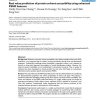Free Online Productivity Tools
i2Speak
i2Symbol
i2OCR
iTex2Img
iWeb2Print
iWeb2Shot
i2Type
iPdf2Split
iPdf2Merge
i2Bopomofo
i2Arabic
i2Style
i2Image
i2PDF
iLatex2Rtf
Sci2ools
BMCBI
2008
2008
Real value prediction of protein solvent accessibility using enhanced PSSM features
Background: Prediction of protein solvent accessibility, also called accessible surface area (ASA) prediction, is an important step for tertiary structure prediction directly from one-dimensional sequences. Traditionally, predicting solvent accessibility is regarded as either a two- (exposed or buried) or three-state (exposed, intermediate or buried) classification problem. However, the states of solvent accessibility are not well-defined in real protein structures. Thus, a number of methods have been developed to directly predict the real value ASA based on evolutionary information such as position specific scoring matrix (PSSM). Results: This study enhances the PSSM-based features for real value ASA prediction by considering the physicochemical properties and solvent propensities of amino acid types. We propose a systematic method for identifying residue groups with respect to protein solvent accessibility. The amino acid columns in the PSSM profile that belong to a certain residue ...
| Added | 09 Dec 2010 |
| Updated | 09 Dec 2010 |
| Type | Journal |
| Year | 2008 |
| Where | BMCBI |
| Authors | Darby Tien-Hao Chang, Hsuan-Yu Huang, Yu-Tang Syu, Chih-Peng Wu |
Comments (0)

